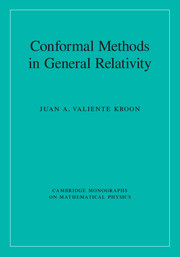Book contents
- Frontmatter
- Dedication
- Contents
- Preface
- Acknowledgements
- List of Symbols
- 1 Introduction
- Part I Geometric tools
- Part II General relativity and conformal geometry
- Part III Methods of the theory of partial differential equations
- Part IV Applications
- 15 De Sitter-like spacetimes
- 16 Minkowski-like spacetimes
- 17 Anti-de Sitter-like spacetimes
- 18 Characteristic problems for the conformal field equations
- 19 Static solutions
- 20 Spatial infinity
- 21 Perspectives
- References
- Index
15 - De Sitter-like spacetimes
from Part IV - Applications
- Frontmatter
- Dedication
- Contents
- Preface
- Acknowledgements
- List of Symbols
- 1 Introduction
- Part I Geometric tools
- Part II General relativity and conformal geometry
- Part III Methods of the theory of partial differential equations
- Part IV Applications
- 15 De Sitter-like spacetimes
- 16 Minkowski-like spacetimes
- 17 Anti-de Sitter-like spacetimes
- 18 Characteristic problems for the conformal field equations
- 19 Static solutions
- 20 Spatial infinity
- 21 Perspectives
- References
- Index
Summary
This chapter discusses the global existence and stability of de Sitter-like spacetimes, that is, vacuum spacetimes with a de Sitter-like value of the cosmological constant. This class of spacetimes admits a conformal extension with a spacelike conformal boundary; see Theorem 10.1. The construction of de Sitter-like spacetimes provides, arguably, the simplest application of the conformal field equations to the analysis of global properties of spacetimes. The original discussion of the analysis presented in this chapter was given in Friedrich (1986b). The results of this seminal analysis were subsequently generalised to the case of Einstein equations coupled to the Yang-Mills field in Friedrich (1991). The methods used in the proof of the stability of the de Sitter spacetime can be adapted to analyse the future non-linear stability of Friedman-Robertson-Walker cosmologies with a perfect fluid satisfying the equation of state of radiation; see Lübbe and Valiente Kroon (2013b).
The global existence and stability theorem proven in this chapter can be formulated as follows:
Theorem (global existence and stability of de Sitter-like spacetimes).Small enough perturbations of initial data for the de Sitter spacetime give rise to solutions of the vacuum Einstein field equations which exist globally towards the past and the future. The solutions have the same global structure as the de Sitter spacetime. Thus, perturbations of the de Sitter spacetime are asymptotically simple.
Intuitively, the last statement in the theorem can be read as saying that the resulting spacetimes have a Penrose diagram similar to the one of the de Sitter spacetime; see Figure 15.1. Accordingly, these spacetimes provide non-trivial (i.e. dynamic) examples of asymptotically simple spacetimes. A detailed formulation of the above result is given in the main text of the chapter; see Theorem 15.1.
To illustrate the comparative advantages of the hyperbolic reduction procedures discussed in Chapter 13, two versions of the proof are provided. The first one makes use of gauge source functions and follows the original proofs in Friedrich (1986b, 1991). The second proof makes use of conformal Gaussian systems and is based on the analysis given in Lübbe and Valiente Kroon (2009).
- Type
- Chapter
- Information
- Conformal Methods in General Relativity , pp. 407 - 436Publisher: Cambridge University PressPrint publication year: 2016

